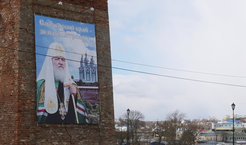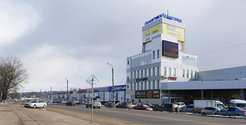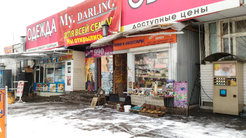Moral economies of small businesses in the postsocialist era: fieldnotes from Russia
Smolensk is located at the Western border of Russia, 360 km west-southwest of Moscow. The city is among the oldest Russian cities and its history dates back to the 9th century. It was caught up in political struggles with Lithuania and Poland in the 14th-17th centuries, occasionally being incorporated into its powerful western neighbor, the Grand Duchy of Lithuania and obliged to adopt Magdeburg Law. Roman Catholicism was propagated in this period and the religious landscape of the city continues to be shaped by diverse Churches and movements, although of course, here as elsewhere in the country, the Orthodox Church seeks to play the leading role as a national religion for all Russians. Let me briefly introduce the most prominent religious communities of the city today.
Smolensk has a tiny Roman Catholic community headed by a priest from Poland. The towers of a magnificent Gothic church dominate its neighbourhood but the building is terribly dilapidated and not open to the public; the Catholic parish has been unable to regain property rights.
Judaism also has historical roots here, since Smolensk was a border region in which Jewish merchants were able to engage actively in economic and cultural life. Moreover, the Smolensk region is a homeland of Habat, the best-known branch of the Hasidic movement, which originated in the village Lyubavichi before later spreading internationally. Nowadays Hebrew-speakers form three different communities in the city. One has a shiny new synagogue in the city centre and a rabbi sent from Israel who does not speak Russian. As elsewhere in Russia, most indigenous Jews who survived the Holocaust have long left the country (mostly going either to Israel or, after the end of the USSR, to Germany).
Numerous Neo-Pentecostal and charismatic churches were established in the city in the 1990s. Business people are conspicuous in at least one of these congregations, where the spirit of entrepreneurship is deliberately nourished by church leaders. For political reasons, charismatic churches have a vulnerable position on the religious market (they are generically suspected of having close connections with US organizations and funds).
The profile of the Russian Orthodox Church (ROC) in Smolensk owes much to the efforts of the Patriarch Kirill, who was Metropolitan here for 25 years before moving to Moscow in 2009. The Patriarch is still visually prominent on posters at the very heart of the city, e.g. on the fortified walls of the Smolensk Kremlin, built in the 16th century. Depicting the Patriarch in his sacerdotal robes beside the Dormition Cathedral, the posters assert that “The Smolensk region is the Patriarch’s land.” Some local clergy interpret tragic events of the 20th century, such as the ‘Katyn shooting’ of 1940 and the plane crash of 2010 that killed the Polish president and his entourage, as God’s punishment for all that Polish Catholics have done to Orthodox lands over the centuries. This version of divine retribution finds resonance among ordinary city dwellers.

In terms of economy, for Smolensk Soviet times (1917 – 1991) were a golden age for large industrial enterprises developed in the framework of central planning. The city’s specializations included aircraft and instrument engineering, diamond faceting, textiles, , and the production of construction materials Major changes began in the second half of the 1980s when ‘perestroika’ introduced elements of market economy and eventually democratic transformations. After 1991 most state owned enterprises were privatized. Many factories have closed entirely, while survivors have undergone massive layoffs, a decline in production, and a far-reaching degeneration of labour conditions. People still regard employment in large factories as safer and more stable than jobs in small firms, but many, especially younger people, choose the latter due to their higher salaries and more flexible working regulations. Flexibility is especially appreciated among mothers with small children as it allows them, for example, to take time off when their child is sick without resorting to the cumbersome formal procedures that are mandatory in such cases at large enterprises.
Compared with other Russian regions, Smolensk ranks among the relatively poor that cannot survive economically without government subsidies. In contrast to regions that thrive on the basis of their natural resources – in accordance with the logic of ‘resource curse’ – the Smolensk lands do not have oil or gas reserves. It does still bear the title of ‘the diamond’s capital’ thanks to the diamond faceting industry that developed here from the 1960s. However, this industry has been severely weakened by international competition and the Smolensk economy nowadays is reported to be heavily dependent on state defense procurement.
In the categories of small and medium business enterprises, statistics indicate that today the commercial, service, and construction sectors dominate. It is common to hear complaints that, whereas in Soviet times countless industrial enterprises produced goods and created jobs, contemporary Russia boasts only glamorous shops inciting people to increase consumption.


The most visible symbol of capitalist transformations is the shopping mall ‘Galaktika’. It was constructed within the walls of a former linen factory that closed in 2005. One building initially designed to serve the factory complex was never completed and excluded from the shopping mall conversion process. With its empty windows and impressive scale, it stands as a memorial to the city’s linen industry and to other ambitious Soviet projects that have inexorably faded away or been degraded within recent memory.
Against this depressing backcloth, I began my study of small family firms when I found a place in a hostel run by siblings with a complicated history of ownership and personal business engagement. For several months I observed everyday life at this establishment, graduating from guest to volunteer worker. Sharing an eight-bedded room with other guests, there was no chance of feeling lonely in a new place. I met a great variety of visitors coming from different parts of Russia and former Soviet Union: students from Moscow who preferred Smolensk universities to expensive metropolitan education , migrants of all sorts seeking Russian citizenship, families from the Northern Caucasus taking advantage of their right to free treatment in the local orthopedic medical center, sportsmen taking part in competitions, traders travelling across the country, and many others besides. People of different ages, social and religious backgrounds, killed time in lively discussions about the latest political news and by sharing their life histories with other visitors and hosts.
Religious issues were raised spontaneously on numerous occasions. Regardless of their religious identities and education, visitors were captivated by TV shows about clairvoyants and magic, which often drew a crowd together in front of the hostel TV set. The prophecies of baba Vanga, a blind Bulgarian mystic who anticipated great world perturbations in the year 2016, were readily retold and discussed in the light of current politics, with a stress on the crucial role of Russia in world affairs. As in many other contexts elsewhere, in particularly tough moments of life people tend to activate their religious identity, even if they have not been active church-goers before. Thus the relatives of those who undergo surgery in the orthopedic hospital felt a need to go to the Orthodox church before the operation to gain spiritual support for the patient. They typically light a candle and pray before the icon, while orthodox dogmatic teachings prescribe a more complex engagement and involvement of the patient himself.
Later I was able to observe another firm of the same owner but it was really awkward not to have a productive role of my own. My presence at the workplace was bizarre for some and openly irritating for others. Eventually I was able to work as a seamstress in a garment manufacturing firm run by mother and her daughter. This allows me to share the shop floor with other women who otherwise I could hardly have interacted with, since they were absorbed in their labour process and had no time to interact with an apparently idle stranger. The case of the garment manufacturing firm demonstrates a pattern of religious engagement specific to business owners. Both the owner and her daughter identify as Orthodox, although they are very critical of the ROC in general. They observe Lent, visit the church for the main religious holidays, worship icons, but do not seek guidance from clergy, who they consider inadequate in many respects. To find out to what extent this pattern is widespread among business people and what other sentiments constitute the moral backgrounds of family firms, in the next phase of my fieldwork I plan to spend more time interviewing business owners in accordance with the design of the REALEURASIA project.


